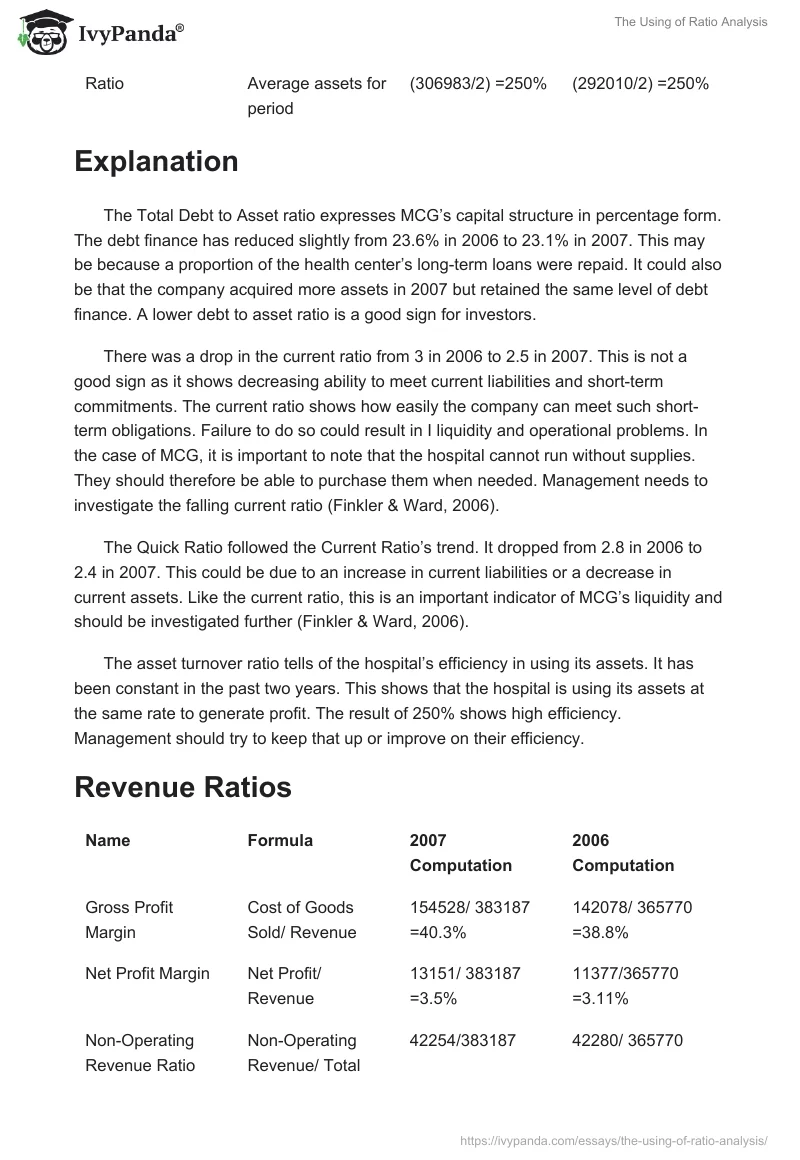Introduction
Ratio analysis is one of the tools that can be used to analyze the performance of a Healthcare Institution. One computes the ratios using standard ratios then compares the results with those of the previous year. Results can be compared with similar healthcare institutions too. This paper will apply ratio analysis to the financial statements of The Medical College of Georgia Health-centre. The subject of the analysis is the financial statements of 2006 and 2007. The focus is on two major categories of ratios: asset and revenue ratios (Reijers, 2005).
Asset Ratios
Asset ratios measure the efficiency with which the institution has used its assets over the period in question. The Asset Turnover ratio is the major ratio in this category. The debt to asset ratio focuses on the MCG’s debt about its total assets. The final category is the liquidity ratios. This category consists of the current and quick ratios. These measure the ability of MCG to pay up its short-term debts promptly. The short-term debts would include salaries and the purchase of medical supplies.
The Total Debt to Asset ratio expresses MCG’s capital structure in percentage form. The debt finance has reduced slightly from 23.6% in 2006 to 23.1% in 2007. This may be because a proportion of the health center’s long-term loans were repaid. It could also be that the company acquired more assets in 2007 but retained the same level of debt finance. A lower debt to asset ratio is a good sign for investors.
There was a drop in the current ratio from 3 in 2006 to 2.5 in 2007. This is not a good sign as it shows decreasing ability to meet current liabilities and short-term commitments. The current ratio shows how easily the company can meet such short-term obligations. Failure to do so could result in I liquidity and operational problems. In the case of MCG, it is important to note that the hospital cannot run without supplies. They should therefore be able to purchase them when needed. Management needs to investigate the falling current ratio (Finkler & Ward, 2006).
The Quick Ratio followed the Current Ratio’s trend. It dropped from 2.8 in 2006 to 2.4 in 2007. This could be due to an increase in current liabilities or a decrease in current assets. Like the current ratio, this is an important indicator of MCG’s liquidity and should be investigated further (Finkler & Ward, 2006).
The asset turnover ratio tells of the hospital’s efficiency in using its assets. It has been constant in the past two years. This shows that the hospital is using its assets at the same rate to generate profit. The result of 250% shows high efficiency. Management should try to keep that up or improve on their efficiency.
Revenue Ratios
Gross Profit Margin has increased from 38.8% to 40.3%. In this question, the cost of salaries was taken as the cost of goods sold. This is because a hospital is a service organization. It, therefore, means that the salaries decreased in 2007. Alternatively, the hospital might have made more profit while paying the same salaries as in 2006.
The Net Profit Margin also increased slightly from 3.11% to 3.5%. This shows that MCG managed its operating expenses better in 2007. The decrease shows higher efficiency. It could also mean that more revenue was earned with the same level of expenses. Whichever way one looks at it, it is an improvement.
The Non-Operating Revenue ratio indicates what percentage of MCG’s revenue was derived from sources other than providing health services. In 2006, it was 11.55% while in 2007 it was 11.02%. This was a slight decrease. It means that the revenue from non-operating activities in proportion to total revenue decreased.
The Operating Revenue ratio is the opposite of the Non-Operating Revenue ratio. It shows the proportion of operating revenue. This ratio increased from 88.5% to 88.9% in 2007. It indicates that MCG is getting more revenue from its core activity. This is the provision of health services.
Conclusion
Ratio analysis can be quite helpful to health facilities. However, several pitfalls need to be avoided. First, it is important to note that ratio analysis is useless without comparative information. Assuming we had only the 2007 financial statements, then ratio analysis would be useless. The figures involved in the analysis are not always accurate. Hence, there may be mistakes in the results. Finally, the results need further explanation, as there may be reasons as to why they are good or bad. However, the usefulness of ratio analysis cannot be understated.
References
Finkler, S., & Ward, D. (2006). Accounting Fundamentals for Health Care Management. Chicago: Jones and Bartlette Publishers.
Reijers, H. (2005). Best practices in business process redesign: an overview and qualitative evaluation of successful redesign heuristics. Omega , 33 (4), 283-306.


